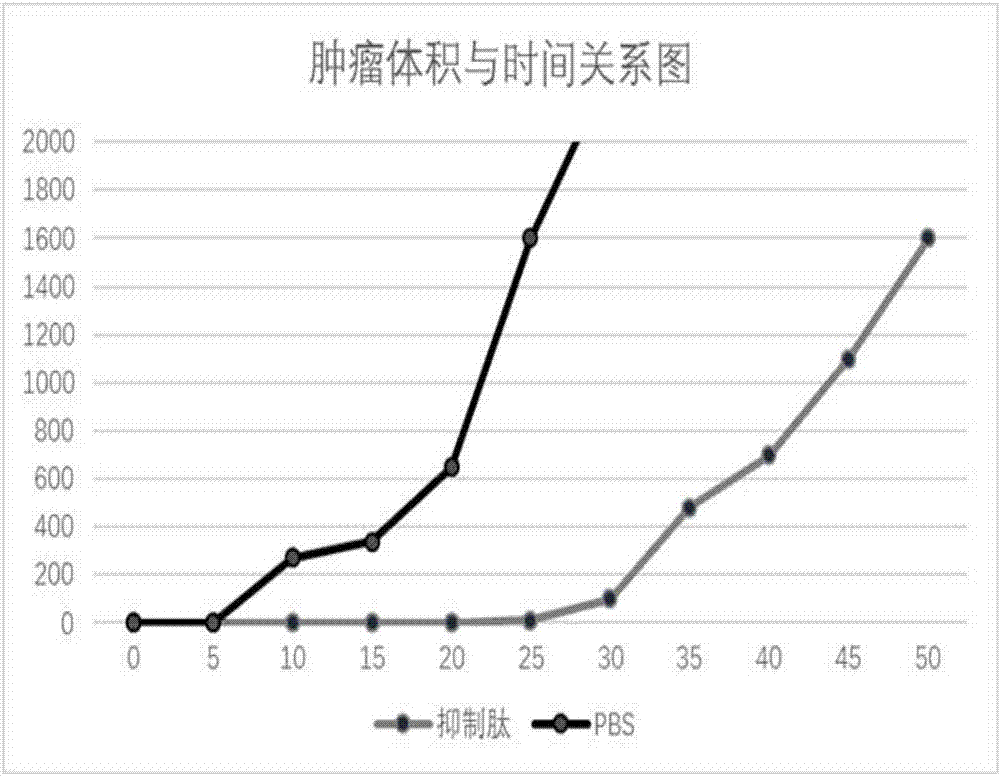Tumor inhibitory peptide capable of being specifically bound with PD-1 and application thereof
A technology of tumor suppression and peptide inhibition, which is applied in the field of disease treatment to achieve good biological activity
- Summary
- Abstract
- Description
- Claims
- Application Information
AI Technical Summary
Problems solved by technology
Method used
Image
Examples
Embodiment 1
[0027] Embodiment one: the acquisition of inhibitory peptide
[0028] The inventor designed the corresponding inhibitory peptides according to the computer-aided design method peptide designer of the inhibitory peptides designed by himself. The design method is to set random short peptides with a length of 25-150 amino acids to make them wander on the surface of PD-1 protein molecules , and change the relative position of the peptide and PD-1 through the charge, quickly calculate the force of each atom on the peptide and the adjacent atoms on the protein surface, as well as the energy change caused by moving and twisting the peptide; and repeatedly optimize and compare various Among the possible binding modes, choose the lowest energy and most fixed conformation. According to the distance and spatial relationship of the interacting atoms, the binding site of the polypeptide to the PD-1 molecule, the participating atomic groups and the mode of action were obtained, and finally ...
Embodiment 2
[0030] Example 2 Determination of the affinity of inhibitory peptides to PD-1
[0031] (1) Prepare the polypeptide with 1×PBS to a solution with a concentration of 1 mg / mL, and prepare the anti-PD-1 polypeptide to a solution with a concentration of 100 μg / mL, take 2.5 μL and drop it on a carboxylated SPR chip (purchased from Plexera company, Kx5 type SPR standard substrate), and the polypeptide was immobilized on the SPR chip through the specific reaction of streptavidin and biotin. Then, the PD-1 solution (diluted in 1×PBS) with concentrations of 0.1 μg / mL, 1 μg / mL, 10 μg / mL, and 50 μg / mL was passed through the chip surface as the mobile phase. The binding time was 150 s, the dissociation time was 130 s, and the regeneration time 200s. 1×PBS was used as the dissociation solution, and 0.5% phosphoric acid was used as the reconstitution solution. The binding-dissociation curves of polypeptides and TNF-α were recorded on a K×5 SPR instrument (Plexera).
[0032](2) Fitting the...
Embodiment 3
[0033] The biological activity detection of embodiment 3 polypeptide inhibitors
[0034] (1) Select JurKat / PD-1 / NFAT cells preserved in the General Microorganism Center of China Microbiological Culture Collection Management Committee with the registration number 10298 as target cells, and use DMEM / F12+10% FBS medium to illuminate 2.5×10 4 cells / well, spread evenly in a 96-well plate at a density of 100 μl / well (corning), 37°C, 5% CO 2 Incubate overnight in the incubator;
[0035] (2) Use 1640+10% fetal bovine serum medium to prepare different concentrations of polypeptide solutions and dilute to 1 μg / mL, then dilute 10 times down to 7 concentration points, and suck off the DMEM / F12+10 in the above 96-well plate %FBS medium, add the prepared peptide inhibitor solution to the 96-well plate according to 50 μl / well;
[0036] (3) Use 1640+10% fetal bovine serum medium to prepare target cell suspension, and follow the 5×10 4 per well, 50 μl / well density evenly spread to the above...
PUM
 Login to View More
Login to View More Abstract
Description
Claims
Application Information
 Login to View More
Login to View More - R&D
- Intellectual Property
- Life Sciences
- Materials
- Tech Scout
- Unparalleled Data Quality
- Higher Quality Content
- 60% Fewer Hallucinations
Browse by: Latest US Patents, China's latest patents, Technical Efficacy Thesaurus, Application Domain, Technology Topic, Popular Technical Reports.
© 2025 PatSnap. All rights reserved.Legal|Privacy policy|Modern Slavery Act Transparency Statement|Sitemap|About US| Contact US: help@patsnap.com

